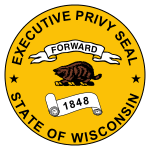Fred R. Zimmerman
| Fred R. Zimmerman | |
|---|---|
 | |
| 25th Governor of Wisconsin | |
|
In office January 3, 1927 – January 7, 1929 | |
| Lieutenant | Henry A. Huber |
| Preceded by | John J. Blaine |
| Succeeded by | Walter J. Kohler, Sr. |
| 22nd & 24th Secretary of State of Wisconsin | |
|
In office January 1, 1923 – January 3, 1927 | |
| Preceded by | Elmer S. Hall |
| Succeeded by | Theodore Dammann |
|
In office January 2, 1939 – December 14, 1954 | |
| Preceded by | Theodore Dammann |
| Succeeded by | Louis Allis |
| Member of the Wisconsin State Assembly | |
|
In office 1909–1911 | |
| Personal details | |
| Born |
November 20, 1880 Milwaukee, Wisconsin |
| Died |
December 14, 1954 (aged 74) Milwaukee, Wisconsin |
| Political party | Republican |
Fred R. Zimmerman (November 20, 1880 – December 14, 1954) was a Republican politician from Milwaukee, who served as a state Assemblyman, 25th Governor of Wisconsin, and Wisconsin Secretary of State. His son Robert C. Zimmerman was also Wisconsin Secretary of State from 1957 until 1975.[1]
Background and early career
Zimmerman was born in Milwaukee, son of Charles E. Zimmerman and Augusta Fiesenhauser Zimmerman, and grandson of German-American Forty-Eighters. His father was born in New York state and came to Milwaukee in 1875. His mother was born in Wisconsin of parents who were natives of Stuttgart. Zimmerman's father, a molder, died when he was 5 and at an early age he began contributing to the support of his family by selling newspapers. After completing grammar school, he attended night school briefly, and held various jobs until he was 22, when he started the Bee Hive Dairy, distributing milk to Milwaukee residents. He left this job, after his marriage, to take a position as a traveling salesman with the Pfister & Vogel Leather Company, and also worked as a bookkeeper for a Milwaukee lumber firm.
Elective office
Legislature
Zimmerman was elected to the Wisconsin State Assembly by six votes in 1908 in a three-way race, receiving 1703 votes on the Republican ticket to 1697 for Democrat Harry R. McLogan, and 1159 for Socialist Gilbert H. Poor, to represent the 8th Milwaukee County district (8th and 23d wards of the City of Milwaukee).[2] He was an active member of the Progressive faction of his party, but served only one term (1909–1910), losing the 1910 election in a four-way contest to Socialist James H. Vint with 1521 votes, to 1501 for Zimmerman, 143 for McLogan, and 12 for Prohibitionist William H. Trout.[3]
Secretary of State
In 1922, Zimmerman (by then an industrial relations manager for Nash Motors) had moved to the Town of Lake and served two years on the Town Board. He received the Republican nomination and election as Wisconsin Secretary of State in 1922 (with 77.7% of the vote in a four-way race) [4] and re-election in 1924 in a five-way race, earning a then-record 509,771 votes statewide.[5] During this period he remained closely identified with the Progressive faction of the Republican Party.
Governor
When the Progressives refused to endorse him in the gubernatorial election in 1926 (because of his failure to support the 1924 Presidential candidacy of Robert M. La Follette, Sr.),[6] Zimmerman ran in the Republican primary election as an "independent" against both Progressive (Herman Ekern) and Stalwart (Charles B. Perry) candidates, as well as another "independent". Zimmerman won the Republican nomination and was elected by an absolute majority, outpolling Stalwart Perry (who came in second, running as an "Independent"), as well as the Democratic, Socialist, Prohibitionist and Socialist Labor candidates combined, with 350,927 votes out of 552,921.[7] In 1928 he was defeated for re-nomination, running a poor third to Stalwart Walter J. Kohler, Sr. and Progressive Congressman Joseph D. Beck.[8]
Thereafter he went into a political decline for several years, briefly holding a position in the Beverage Tax Commission in 1936.
Secretary of State once more
Zimmerman was nominated and elected Secretary of State on the Republican ticket in 1938 and served until his death, polling a larger vote at each subsequent election and in 1952 again received the highest total ever given any candidate for any office in the state.
Private life
Zimmerman was a delegate to the Republican National Conventions in 1916, 1920, 1924, 1940, and 1944. He was attacked as a member of America First, but he denied membership therein, although he generally followed the isolationist position. He died in Milwaukee in 1954 just after again winning re-election as Secretary of State.
References
- ↑ Zimmerman biodata
- ↑ Beck, J. D., ed. The blue book of the state of Wisconsin Madison: Democrat Printing Co., State Printer, 1909; pp. 529, 1130.
- ↑ Beck, J. D., Ed. The blue book of the state of Wisconsin Madison: Democrat Printing Company, State Printer, 1911; p. 347
- ↑ The Wisconsin blue book, 1923 Madison: The State Printing Board, 1923; pp. 567, 603
- ↑ Holmes, Fred L., ed. The Wisconsin blue book, 1925; Madison: Democrat Printing Company, State Printer, 1925; pp. 484, 566, 640-641
- ↑ "POLITICAL NOTES: In Wisconsin" Time Sept. 6, 1926
- ↑ Holmes, Fred L., ed. The Wisconsin blue book, 1927. Madison: Democrat Printing Company, State Printer, 1927; pp. 494, 573.
- ↑ Anderson, William J.; Anderson, William A., eds. The Wisconsin blue book, 1929 Madison: Democrat Printing Company, State Printer, 1929; p. 736
Further reading
| Political offices | ||
|---|---|---|
| Preceded by John J. Blaine |
Governor of Wisconsin 1927 – 1929 |
Succeeded by Walter J. Kohler, Sr. |

